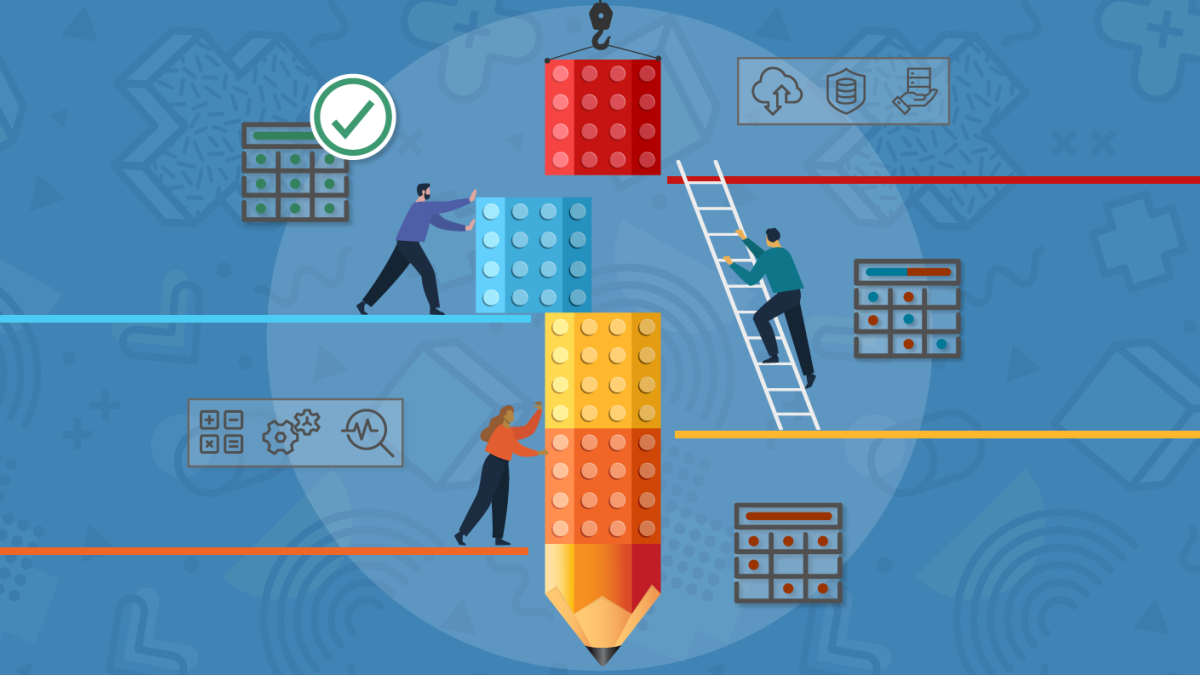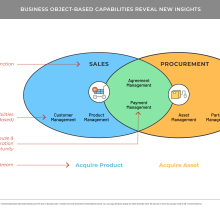What’s a composable business? As Gartner describes it, "Composable business means creating an organization made from interchangeable building blocks."1 Composable means modularity. The composable business is perhaps one of the newer ways to describe the modular design of organizations to leverage common business components.
Here’s the straight talk though, a business architecture is THE definition of modular, reusable business components for an organization. So, if you’re looking to demystify what these common business components actually are, look no further. The future is composable and there are many compelling benefits for organizations to follow this approach. Read on.
What is modularity?
Wikipedia defines modularity as “the degree to which a system’s components may be separated and recombined.”2
We can find modularity all around us from the design of buildings and products to nature itself (e.g., marvel at honeycombs, plants, the skins and coverings of animals, elements within the human body, and so much more). The concept of modularity very much applies to the design of organizations as well where we have reusable business components that are created once and leveraged in many different ways.
How does modularity benefit an organization?
The essence is that we want to design our organizations to deliver value today (and generate revenue if that organization is for-profit), while preparing for a very different tomorrow as the world continues to shift based on forces such as digital, globalization, changing perspectives, governance, and other trends.
Leveraging common business components facilitates organizational agility. And organizational agility leads to resilience and competitive advantage. Here are a few examples:
- Rapid Innovation – Common business components can be reused and recombined in different ways that allow an organization to deliver new value, products, and services to customers.
- Integrated Experiences and Solutions – Common business components can be assembled across customer, partner and employee experiences, creating seamless integration and consistency.
- Rapid Business Changes and Strategy Execution – Common business components allow changes to be made faster because those changes only need to be made one time. (Compare this to many instances of processes and automation that may exist in siloed or legacy environments.) The quicker an organization can move its ideas into action, the greater the competitive advantage.
So, what are these common business components?
Capabilities. They are at the heart of an organization’s business architecture and the one domain that connects to every other business architecture domain (there are 9 more). Capabilities also connect to domains from other disciplines as well as the operating model.
Of course, value streams are critical as well because they put capabilities within a business value context and help to connect them to customer journeys.
P.S. For more background on the domains of business architecture, check out Posts No. 1, No. 12, and No. 13. For more on capabilities, in particular, check out Posts No. 51, No. 52 and No. 53.
Tell me more about these capabilities.
First, it is important to note that capabilities are high-level abstractions of what an organization does, and they help us to frame and organize people, process, information, and technology.
We can leverage capabilities as reusable building blocks to help us innovate as mentioned earlier. In addition, from a business change and strategy execution perspective, capabilities (in value stream context) help us to frame and align what changes need to be made to people, process, information and technology to achieve a desired state.
This means that capabilities (and value streams) are typically not created or changed themselves (unless an organization’s business model has changed), but rather it is the people, process or technology (operating model) – or other business architecture domains – related to them which are changed or uplifted.
How else can capabilities help?
There’s more.
In addition to serving as the focal point for common business components, capabilities also:
- Create a shared business vocabulary and mental model across an entire organization, which creates effective collaboration and even leads to rationalized data.
- Work hand-in-hand with value streams to help translate strategies and business changes into a clear and cohesive set of business direction. This aligns teams to organization-wide objectives and thereby empowers them. (P.S. See more on strategy translation with business architecture in Post No. 81.)
- Underpin the entire end-to-end strategy execution pathway (along with the rest of the business and IT architecture), which creates comprehensive organizational agility and alignment. (P.S. See more on strategy execution in Posts No. 3, No. 50 and No. 72.)
In her article entitled “Architect Your Company for Agility,” Jeanne Ross describes three mechanisms for achieving alignment across teams: (1) clear missions, (2) common business components, and (3) fruitful knowledge sharing. As you can see, business architecture answers the call for all three.
What about the shift towards product-based IT and product-oriented operating models?
There are great benefits to the shifts these approaches can bring, such as ensuring that teams are dedicated and longstanding, perpetually funded, and value-driven. (See this article for example.) However, the challenge still lies in the definition of product and capability. In this case, the devil is in the details.
As we know, in business architecture products and customers are external ecosystem concepts, never internal ones. (See Post No. 63 for clarification.) In other words, products and services are the things an organization offers in the market and customers are individuals or organizations that have an agreement with the organization for those products and services, or otherwise benefit from them.
In contrast, in the product-based paradigm, product is frequently not defined as the products and services that the organization offers in the market, but rather a different type of grouping, often functional or otherwise. For example, it is a movement in the right direction to organize not around specific IT systems (e.g., SAP), but organizing around groupings such as eCommerce, Supply Chain or Human Resources still does not get to the unique essence that are described in capabilities.
Refer to the diagram below which illustrates how capabilities break an organization down into its most reusable, common business components, which can be leveraged across functions. (In this case, Agreement Management and Payment Management can be leveraged for both Sales and Procurement.)
Looking at products through the business architecture lens gives us a different take, as is shown below using an insurance example. Products are defined within the context of the external customer. Capabilities enable those products, and technology automates those enabling capabilities. This approach ensures a continual focus on serving the ultimate customers of an organization.
Even if your organization has already organized around products in a different way, the great news is that you can still use capabilities as a way to align teams and ensure they leverage common business components, collaborate and share knowledge where applicable.
Where do we go from here?
As described in the Gartner article, for an organization to leverage the concepts of modularity and common business components, there are three building blocks required for a composable business:
- Composable thinking – It is critical to embed modular thinking across the organization, including within the mindset of business leaders.
- Composable business architecture – The foundation of a composable business! The key here is to help people understand the benefits and concepts of modularity, but bring them back to the BIZBOK® Guide mapping approach as well as the practicality you’ve learned from StraightTalk and how all of the pieces fit together.
- Composable technologies – This follows right on from the business architecture, reflected in the IT architecture as applications and reusable software services.
The future is composable. Go design your world!
More Good Stuff...
Architect Your Company For Agility (MIT Sloan by Jeanne Ross): Pure gold. This will help you make a case for business and enterprise architecture. “…a great strategy is valuable only if a company is capable of executing that strategy. And whether or not a company can execute its strategy depends largely on whether it is designed to do so. In other words, it depends on business architecture – the way a company’s people, processes, systems, and data interact to deliver goods and services to customers.”
Designed for Digital: How to Architect Your Business for Sustained Success (Management on the Cutting Edge) (Book by Ross, Beath and Mocker): A must-read and also a valuable resource to share with executives. It will help you make the case for business architecture.
Designed for Digital (Video by Jeanne Ross): An excellent overview of the core concepts of the Designed for Digital book. This is a must-watch.
The Future of Business Is Composable (Gartner): This article makes the case for business modularity and highlights the role of business architecture.
The Myth of Business Architecture for IT (Business Architecture Guild® recorded webinar): This is a useful webinar to learn more about the concept of products from a business architecture perspective and other valuable concepts. (Business Architecture Guild® membership required.)
The Biomimicry Institute: Design ideas from our greatest teacher: nature.
Floating Cities, the LEGO House, and Other Architectural Forms of the Future (TED Talk): A fun and fascinating TED Talk by architect Bjarke Ingels that provides a worldwide tour of his team's projects, including the LEGO Home of the Brick in Denmark. (The ultimate example of modularity.) Just cool.
Puppies! Now That I’ve Got Your Attention, Complexity Theory (TED Talk): An entertaining and thought-provoking TED Talk by Nicolas Peroni, inspired by animal behavior, that explores what it means for a system to be complex – not complicated. There are important lessons for organizations here. Simplicity leads to complexity, which leads to resilience. And competitive advantage.


